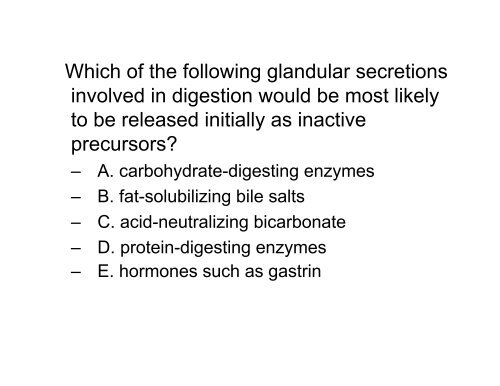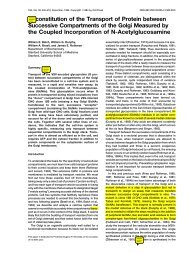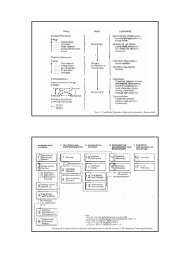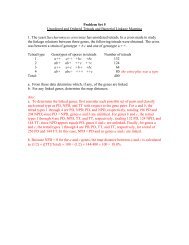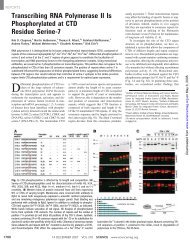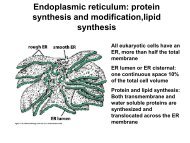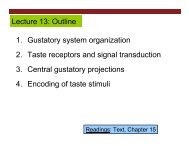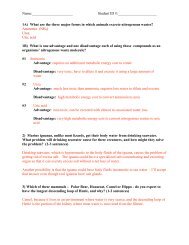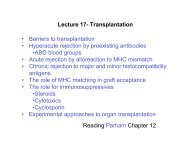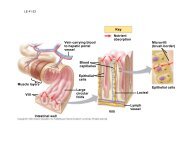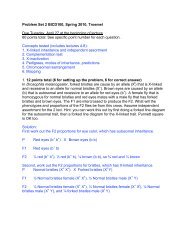Which of the following glandular secretions involved in digestion ...
Which of the following glandular secretions involved in digestion ...
Which of the following glandular secretions involved in digestion ...
You also want an ePaper? Increase the reach of your titles
YUMPU automatically turns print PDFs into web optimized ePapers that Google loves.
<strong>Which</strong> <strong>of</strong> <strong>the</strong> <strong>follow<strong>in</strong>g</strong> <strong>glandular</strong> <strong>secretions</strong><br />
<strong><strong>in</strong>volved</strong> <strong>in</strong> <strong>digestion</strong> would be most likely<br />
to be released <strong>in</strong>itially as <strong>in</strong>active<br />
precursors?<br />
– A. carbohydrate-digest<strong>in</strong>g enzymes<br />
– B. fat-solubiliz<strong>in</strong>g bile salts<br />
– C. acid-neutraliz<strong>in</strong>g bicarbonate<br />
– D. prote<strong>in</strong>-digest<strong>in</strong>g enzymes<br />
– E. hormones such as gastr<strong>in</strong>
LE 41-22<br />
Liver<br />
Key<br />
Stimulation<br />
CCK<br />
Enterogastrone<br />
Gallbladder<br />
Stomach<br />
Inhibition<br />
Gastr<strong>in</strong><br />
Pancreas<br />
Duodenum<br />
Secret<strong>in</strong><br />
CCK
Absorption <strong>of</strong> Nutrients<br />
• The small <strong>in</strong>test<strong>in</strong>e has a huge surface<br />
area, due to villi and microvilli that are<br />
exposed to <strong>the</strong> <strong>in</strong>test<strong>in</strong>al lumen<br />
• The enormous microvillar surface<br />
greatly <strong>in</strong>creases <strong>the</strong> rate <strong>of</strong> nutrient<br />
absorption
LE 41-23<br />
Ve<strong>in</strong> carry<strong>in</strong>g blood<br />
to hepatic portal<br />
vessel<br />
Key<br />
Nutrient<br />
absorption<br />
Microvilli<br />
(brush border)<br />
Blood<br />
capillaries<br />
Muscle layers<br />
Villi<br />
Epi<strong>the</strong>lial<br />
cells<br />
Large<br />
circular<br />
folds<br />
Lacteal<br />
Epi<strong>the</strong>lial cells<br />
Intest<strong>in</strong>al wall<br />
Villi<br />
Lymph<br />
vessel
• Each villus conta<strong>in</strong>s a network <strong>of</strong> blood vessels and a<br />
small lymphatic vessel called a lacteal
• Am<strong>in</strong>o acids and sugars pass through <strong>the</strong> epi<strong>the</strong>lium <strong>of</strong> <strong>the</strong><br />
small <strong>in</strong>test<strong>in</strong>e and enter <strong>the</strong> bloodstream<br />
• After glycerol and fatty acids are absorbed by epi<strong>the</strong>lial<br />
cells, <strong>the</strong>y are recomb<strong>in</strong>ed <strong>in</strong>to fats with<strong>in</strong> <strong>the</strong>se cells<br />
• These fats are mixed with cholesterol and coated with<br />
prote<strong>in</strong>, form<strong>in</strong>g molecules called chylomicrons, which are<br />
transported <strong>in</strong>to lacteals
LE 41-24<br />
Fat globule<br />
Bile salts<br />
Fat droplets<br />
coated with<br />
bile salts<br />
Micelles made<br />
up <strong>of</strong> fatty acids,<br />
monoglycerides,<br />
and bile salts<br />
Epi<strong>the</strong>lium<br />
<strong>of</strong> small<br />
<strong>in</strong>test<strong>in</strong>e<br />
Epi<strong>the</strong>lium<br />
<strong>of</strong> lacteal<br />
Lacteal
The Large Intest<strong>in</strong>e<br />
• The large <strong>in</strong>test<strong>in</strong>e, or colon, is connected to<br />
<strong>the</strong> small <strong>in</strong>test<strong>in</strong>e<br />
• Its major function is to recover water that<br />
has entered <strong>the</strong> alimentary canal<br />
• Wastes <strong>of</strong> <strong>the</strong> digestive tract, <strong>the</strong> feces,<br />
become more solid as <strong>the</strong>y move through<br />
<strong>the</strong> colon<br />
• Feces pass through <strong>the</strong> rectum and exit via<br />
<strong>the</strong> anus
• The colon houses stra<strong>in</strong>s <strong>of</strong> <strong>the</strong> bacterium<br />
Escherichia coli, some <strong>of</strong> which produce vitam<strong>in</strong>s
After a meal <strong>of</strong> greasy french fries, which<br />
enzymes would you expect to be most<br />
active?<br />
– A. lipase, lactase, maltase<br />
– B. salivary and pancreatic amylase,<br />
disaccharidases, lipase<br />
– C. peps<strong>in</strong>, tryps<strong>in</strong>, chymotryps<strong>in</strong>, dipeptidases<br />
– D. gastric juice, bile, bicarbonate<br />
– E. sucrase, lipase, bile
Concept 41.5: Evolutionary<br />
adaptations <strong>of</strong> vertebrate digestive<br />
systems are <strong>of</strong>ten associated with<br />
diet<br />
• Digestive systems <strong>of</strong> vertebrates are<br />
variations on a common plan<br />
• However, <strong>the</strong>re are <strong>in</strong>trigu<strong>in</strong>g<br />
adaptations, <strong>of</strong>ten related to diet
Some Dental Adaptations<br />
• Dentition, an animal’s assortment <strong>of</strong> teeth, is one<br />
example <strong>of</strong> structural variation reflect<strong>in</strong>g diet<br />
• Mammals have specialized dentition that best<br />
enables <strong>the</strong>m to <strong>in</strong>gest <strong>the</strong>ir usual diet
LE 41-26<br />
Incisors<br />
Can<strong>in</strong>es<br />
Carnivore<br />
Premolars<br />
Molars<br />
Herbivore<br />
Omnivore
Stomach and Intest<strong>in</strong>al<br />
Adaptations<br />
• Herbivores generally have longer alimentary canals<br />
than carnivores, reflect<strong>in</strong>g <strong>the</strong> longer time needed to<br />
digest vegetation
LE 41-27<br />
Small <strong>in</strong>test<strong>in</strong>e<br />
Small<br />
<strong>in</strong>test<strong>in</strong>e<br />
Stomach<br />
Cecum<br />
Colon<br />
(large<br />
<strong>in</strong>test<strong>in</strong>e)<br />
Carnivore<br />
Herbivore
Symbiotic Adaptations<br />
• Many herbivores have fermentation<br />
chambers, where symbiotic microorganisms<br />
digest cellulose<br />
• The most elaborate adaptations for an<br />
herbivorous diet have evolved <strong>in</strong> <strong>the</strong> animals<br />
called rum<strong>in</strong>ants
LE 41-28<br />
Intest<strong>in</strong>e<br />
Rumen<br />
Reticulum<br />
Abomasum<br />
Esophagus<br />
Omasum
LE 41-23<br />
Ve<strong>in</strong> carry<strong>in</strong>g blood<br />
to hepatic portal<br />
vessel<br />
Key<br />
Nutrient<br />
absorption<br />
Microvilli<br />
(brush border)<br />
Blood<br />
capillaries<br />
Muscle layers<br />
Villi<br />
Epi<strong>the</strong>lial<br />
cells<br />
Large<br />
circular<br />
folds<br />
Lacteal<br />
Epi<strong>the</strong>lial cells<br />
Intest<strong>in</strong>al wall<br />
Villi<br />
Lymph<br />
vessel


